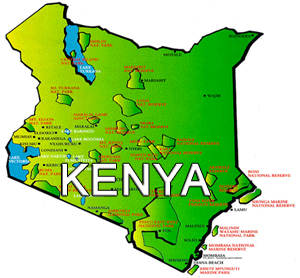After the drought, the deluge: Kenya braces for flooding
 Nairobi - The rain comes down in sheets in the Kenyan capital Nairobi, sending pedestrians splashing for cover through muddy streams that send the detritus of city life swirling around their ankles.
Nairobi - The rain comes down in sheets in the Kenyan capital Nairobi, sending pedestrians splashing for cover through muddy streams that send the detritus of city life swirling around their ankles.
Many a pair of shiny shoes are caked in mud and those without umbrellas are soaked to skin, but nobody complains. The rains have been a long time coming in Kenya.
The East African nation - and the wider region - has been suffering from several years of failed rains, shrivelling the earth, decimating cattle herds and bringing millions to the brink of starvation.
The short rains began last week, and according to the Kenya Meteorological Department, the rain, driven by El Nino, will be heavier than average.
The weathermen say the rain will ensure a good harvest in Kenya's breadbasket areas and also fall on the arid and semi-arid regions, where pastoralists have been peering hopefully at the skies as the skeletal remains of their cattle crumble into the dust.
The hydroelectric dams that power much of the country also are filling up again - bringing hope that the power rationing which has hobbled Nairobi for months will end.
But as welcome as the rains are, they could bring more misery for many of those communities weakened by the long drought.
International aid agency Oxfam in late September warned that 23 million people across East Africa were in need of food aid, some 3.8 million of them in Kenya.
Now the agency says the rains place these people in further peril.
"The rains will potentially bring relief in a few months time as it helps with harvest ... but any positive effects can be offset with negatives," Alun McDonald, a regional spokesman for Oxfam Great Britain, told the German Press Agency dpa.
"Cattle are very weak and susceptible to disease, which can spread with heavy rains," he added. "The same goes with children: malnourished children are vulnerable to cholera and water-borne diseases."
The United Nations Children's Fund UNICEF, which says that 500,000 children will have faced life-threatening malnutrition in the region by the end of this year, has also warned of possible catastrophe while the UN Office for the Coordination of Humanitarian Affairs cautions the rains could be devastating.
"We continue to need massive help to deal with this," said UN Emergency Relief Coordinator and Under-Secretary-General for Humanitarian Affairs John Holmes. "An additional shock in this intersection of human vulnerabilities would be devastating."
Heavy flooding, landslides and fierce storms are expected during the short rains - which run from mid-October to December.
Thousands of people have already been flooded out of their homes in the Tana Delta and sections of the road linking Nairobi with the port town Mombasa were washed away.
According to the UN as many as 750,000 people in Kenya alone could be affected by the rains.
In eastern Kenya, at the Dadaab refugee camp, it began raining just over a week ago. Dadaab hosts almost 300,000 Somalis sheltering from a bloody conflict in their own country. Almost a third of these refugees may have to be moved.
"In a worst case scenario, we're looking at evacuating upwards of 110,000 refugees," Richard Acland, the head of the United Nations Refugee Agency's Dadaab office, told dpa. "About 2,00 people have already been moved to higher ground."
The camp is already hopelessly overcrowded and according to Acland, the refugees would simply have to be crammed even closer together unless Kenya urgently parts with more land.
The Word Food Programme has begun pre-positioning food supplies for areas in the east of Kenya likely to be cut off by the rains.
In other remote regions like the north-western Turkana, the consequences could be disastrous for tribesmen who have already lost most of their cattle.
"The Turkana are worried that the rains could finish off the last of their cattle, either by diseases or through being washed away in floods," McDonald said. (dpa)